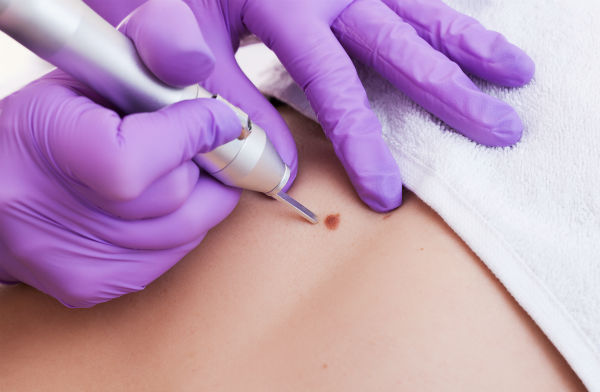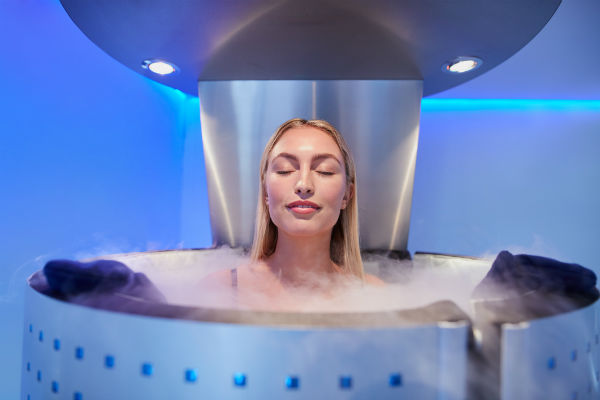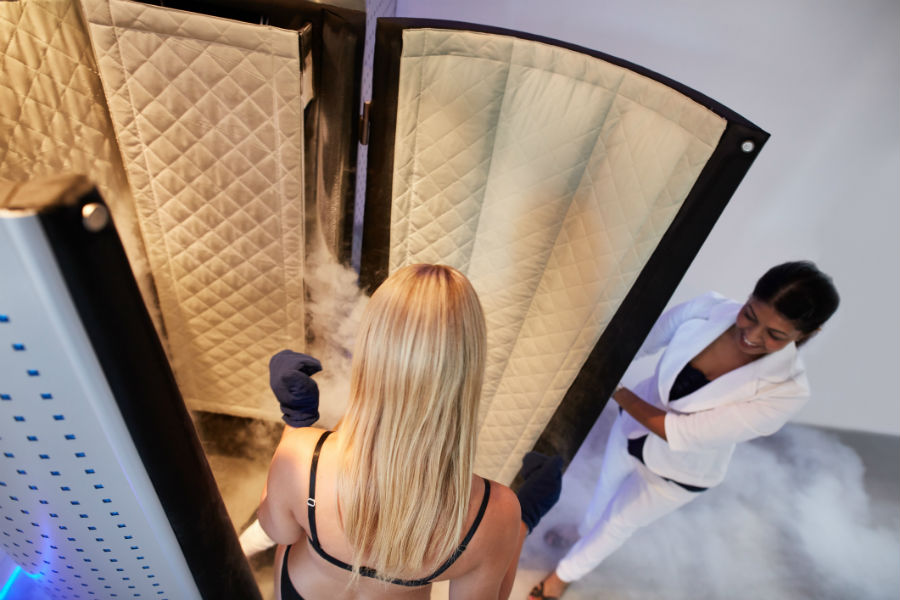So you’re thinking of trying cryotherapy.
The cold therapy treatment is more accessible than ever, popping up at gyms and spas across the country. Here in NYC, it’s beyond easy to find. Some companies are even partnering with gyms like Equinox to offer members discounts to try out the quick spa sessions. But what is it and is it even worth the money? We’ll break down what you can expect from this treatment, which benefits are backed by science and which might be hype, as well as what you can expect to pay for a single session.
What is cryotherapy, anyway?
Cryotherapy isn’t anything new. Though it’s a newer wellness trend to go into a cryotherapy chamber, the treatment itself has been used by doctors for years. Doctor’s offices use cryotherapy to freeze off warts and kill abnormal or cancerous cells on the skin on cervix. It’s relatively pain-free and can be more affordable than some other treatments.

The trendy spa treatment is a bit different, though. Instead of localized cold, you’re getting the chilly treatment across most of your body. And in your underwear. OK, we all know it’s cold therapy, but how cold are we talking? This treatment, which asks you to stand inside a chamber for anywhere from 2 to 4 minutes, plunges your body into temperatures below -200 degrees F.
Why in the world would I do that?
Good question. Although there are cryotherapy benefits, most people talk about the calorie burn when they’re thinking of jumping on this trend. Fans claim that the treatment can burn anywhere from 500 to 800 calories. We’re going to go ahead and clear something up right now. You hear people talking about this calorie burn, but no, 2 to 4 minutes will not burn this high amount of calories.
What they really mean is that some people claim the treatment forces your body to burn more by warming itself back up. This 500-800 range comes from increased calorie burn throughout the rest of the day, following a treatment. You’re not going to pop out of a cryotherapy chamber suddenly free of the calories from those 2 slices of pizza you ate last night.
So what are the cryotherapy benefits?
Perhaps the most studied and most guaranteed benefit of cryotherapy is the deflation of inflammation. It’s why you ice injuries and athletes take ice baths. The cold therapy will bring down inflammation, and the colder the better for this muscle-soothing benefit.
Cryotherapy makes you feel good
As unscientific as that claim sounds, there are studies backing it up. A whole body cryotherapy session results in a rush of feel-good hormones called endorphins (like norepinephrine), a study showed. That gives you a “high” after those 3 minutes in the cold tank.
Other studies have gone further, trying to discover whether cryotherapy can be used as a supplementary treatment for mood disorders like depression and anxiety. Participants in one study did show a decrease in negative mood markers. Cryotherapy was used as a supplement on top of their medicine. (Please do not stop taking your prescription in favor of cryotherapy!) But it’s worth noting they were subjected to 15 rounds of 3-minute cryo sessions each day for three weeks.
Cryotherapy can ease your pain
While the studies mentioned above looked at the mental benefit of cryotherapy, researchers have also studied the physical benefits. Patients with akylosing spondylitis, a type of arthritis that affects the spine, saw double the results if they were treated with cryotherapy in addition to physical therapy in one study. That means that not only did their pain intensity decreased more but their spine mobility also increased.
In fact, medical practitioners have used cryo since the 1970s as a treatment for rheumatoid arthritis. Its benefit for an average healthy human has been less studied, but can be safely inferred. If whole body cryotherapy helps people with severe arthritis, it will work wonders for people with sore joints. That means athletes and even the average gym goer can benefit from a pop into the cryotherapy chamber.
Which of the cryotherapy benefits are hype?
With so many purported health benefits, how can you tell what’s hype? That’s where we tapped into expert opinion and the peer-reviewed studies to help us see through the rose-tinted claims. Here’s what’s probably a little bit too good to be true about cryotherapy:
Cryotherapy for weight loss
For starters, probably that calorie claim. In theory, yes, extended time in cold temperatures does force your body to work harder to bring your core temperature back up to normal through shivering and various internal processes, Brian Quebbemann, M.D., medical director of The N.E.W. Program in Newport Beach, explained to Women’s Health.
People who spent two hours daily for six days did burn more calories in a study than their warmer counterparts. It has also been shown that sleeping in a room that’s around 66 degrees F boosts your conversion of white fat to metabolically active brown fat. That means, over time, you would increase the calories you burn each day just sitting around. But the 42 percent increase in brown fat only corresponded to a 10 percent rise in metabolic rate. (If your resting metabolic rate is 1700 calories per day, that’s an underwhelming additional 17 calories per day.) But as soon as they stopped sleeping in the cold, their brown fat levels returned to normal.
What’s more, even 6 months of cryotherapy had no effect on body mass or body fat, even combined with moderate aerobic exercise, a study found. “There is no scientific evidence that three minutes of whole-body cryotherapy results in any long-term weight loss whatsoever,” Quebbemann summarizes.
But there are different types of cryotherapy chambers
Cryotherapy sessions differ, although the “bucket” type of cryo is the most common. Those are the chambers that have you stand inside with your head sticking out of the top. Most spas and gyms that boast cryotherapy have this type of chamber. Unfortunately, some claim that the difference in cryotherapy chamber can mean a great deal when it comes to whether you get the health benefits or not.
Your head does need to stick out since most chambers use nitrogen to get that signature frosty feeling. We can’t breathe pure nitrogen. But since your head is sticking out and there’s an opening in the chamber, room-temperature air can get in. For many, this means their lower body is left feeling cold while their upper body never cools down.

The other type of cryotherapy chamber is full submersion. They use regular air, not nitrogen, so you walk into a chamber. Every part of you from the top of your head to the tips of your toes gets the cold therapy with this type. Exposing your head to cryotherapy activates your vagus nerve, which can lower stress by lessening your flight or fight response. But since the nerve is at the back of the head, you don’t get this benefit with “bucket” cryotherapy.
Is cryotherapy dangerous?
Like any other spa treatment, there are some risks with cold therapy. But you eliminate this risk by going to a spa where an attendant helps you through the treatment. Since you’re exposed to extreme cold, you want someone watching you in case something goes wrong.
The “bucket” cryo sessions also involve some risk if you don’t listen to instructions. Nitrogen can burn the skin, but spas have procedures in place to prevent this. Make sure you go to a place that provides thick socks, gloves, and a headband to protect your ears. This also eliminates the risk of frostbite.
Lastly, never duck your head down into a “bucket” cryotherapy chamber. We cannot breathe pure nitrogen. If you submerge your head and end up breathing it in, you can pass out. Passing out in a cryo chamber is dangerous, even with an attendant there to help you. But you can also choose to go to a spa that offers cryotherapy using pure air and no nitrogen. That’s eliminates the risk of breathing nitrogen entirely.
How much does cryotherapy cost?
So you’ve made it this far and you’re still thinking of trying whole body cold therapy. But how much can you expect to drop on a single session of cold therapy? Many spas offering this service provide packages to keep costs as low as they can, but you likely won’t purchase one before trying it. That’s why we’re filling you in one the single-session cost. Just keep in mind that if you like the service and want to do it more regularly, you’ll probably save some dough.
Many places offering cryo charge around $60 or $70 for a single session of 2 to 4 minutes in the chamber. That can be a hefty price tag, especially when you don’t know how you’ll feel afterwards. But make sure to check out the package options if you’re still curious. While you may shell out $70 for the first session, you’ll likely pay less if you like it and can commit to a bundle of treatments.

1 thought on “The dirt on cryotherapy”
Comments are closed.